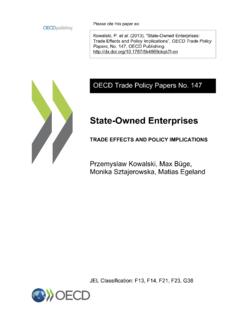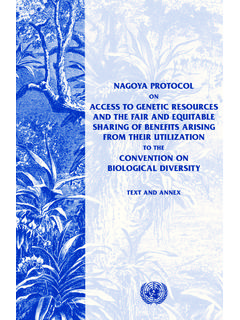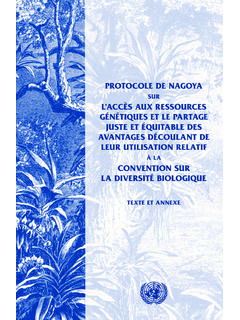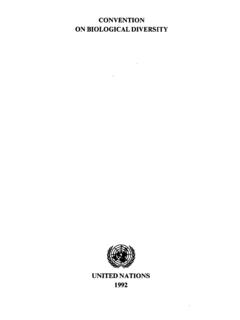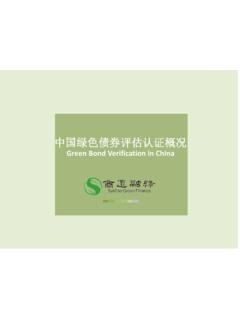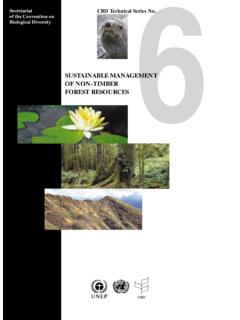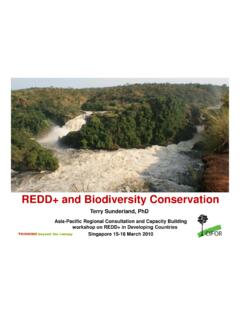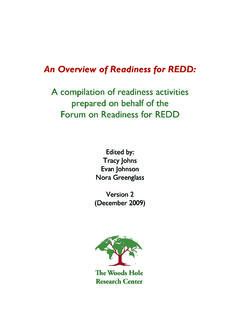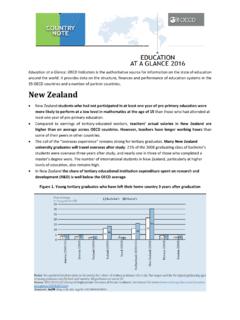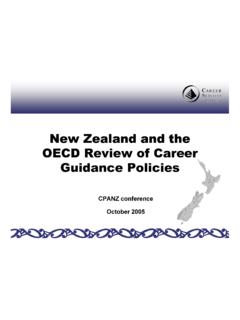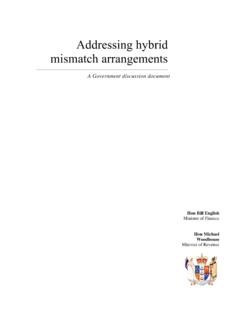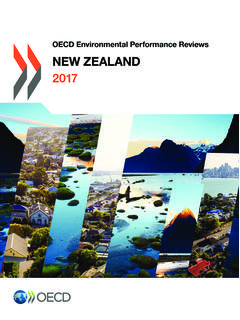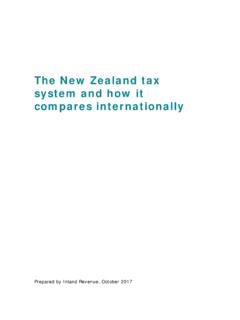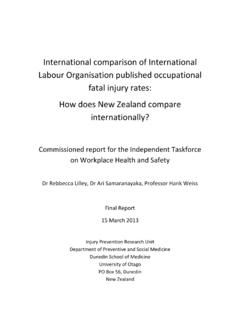Transcription of NEW ZEALAND - CBD
1 NEW ZEALAND Development Assistance Committee (DAC) PEER REVIEW 2010 ORGANISATION FOR ECONOMIC CO-OPERATION AND DEVELOPMENT INTRODUCTION 3 DAC PEER REVIEW OF NEW ZEALAND OECD 2011 The Peer Review Process The DAC conducts periodic reviews of the individual development co-operation efforts of DAC members. The policies and programmes of each member are critically examined approximately once every four or five years. Five members are examined annually. The OECD s Development Co-operation Directorate provides analytical support and is responsible for developing and maintaining the conceptual framework within which the Peer Reviews are undertaken.
2 The Peer Review is prepared by a team, consisting of representatives of the Secretariat working with officials from two DAC members who are designated as examiners . The country under review provides a memorandum setting out the main developments in its policies and programmes. Then the Secretariat and the examiners visit the capital to interview officials, parliamentarians, as well as civil society and NGO representatives of the donor country to obtain a first-hand insight into current issues surrounding the development co-operation efforts of the member concerned. Field visits assess how members are implementing the major DAC policies, principles and concerns, and review operations in recipient countries, particularly with regard to poverty reduction, sustainability, gender equality and other aspects of participatory development, and local aid co-ordination.
3 The Secretariat then prepares a draft report on the member s development co-operation which is the basis for the DAC review meeting at the OECD. At this meeting senior officials from the member under review respond to questions formulated by the Secretariat in association with the examiners. This review contains the Main Findings and Recommendations of the Development Assistance Committee and the report of the Secretariat. It was prepared with examiners from Austria and the European Union for the Peer Review of New ZEALAND on 8 December 2010. In order to achieve its aims the OECD has set up a number of specialised committees.
4 One of these is the Development Assistance Committee, whose members have agreed to secure an expansion of aggregate volume of resources made available to developing countries and to improve their effectiveness. To this end, members periodically review together both the amount and the nature of their contributions to aid programmes, bilateral and multilateral, and consult each other on all other relevant aspects of their development assistance policies. The members of the Development Assistance Committee are Australia, Austria, Belgium, Canada, Denmark, Finland, France, Germany, Greece, Ireland, Italy, Japan, Korea, Luxembourg, the Netherlands, New ZEALAND , Norway, Portugal, Spain, Sweden, Switzerland, the United Kingdom, the United States and the Commission of the European Communities.
5 4 INTRODUCTION DAC PEER REVIEW OF NEW ZEALAND OECD 2011 New ZEALAND s aid at a glance Exchange rate (NZD per USD) 2006 2007 2008 2009 TABLE OF CONTENTS 5 DAC PEER REVIEW OF NEW ZEALAND OECD 2011 Table of contents Acronyms .. 9 The DAC s main findings and recommendations .. 11 Secretariat report .. 21 Chapter 1 Strategic orientations .. 21 An evolving aid programme in a challenging geographical context .. 21 A programme in transition .. 21 The Pacific context .. 21 Strategic foundations of New ZEALAND s development co-operation .. 22 An integrated institutional framework .. 22 New ZEALAND s aid policy: a shift in emphasis .. 23 Communicating the vision better.
6 25 Integrating cross-cutting issues into the aid programme .. 25 Communication: building public awareness and support .. 27 The need for greater public and political support .. 27 The need to raise development awareness and communicate results .. 29 Future considerations .. 30 Chapter 2 Policy coherence for development .. 31 Political commitment: a pragmatic approach to policy coherence for development .. 31 Institutional framework .. 33 Strengthened co-ordination mechanisms .. 33 Whole-of-government approaches to aid delivery: going beyond stand-alone projects .. 35 Capacity, monitoring and reporting .. 36 Future considerations .. 37 Chapter 3 ODA volumes, channels and allocations.
7 39 Overall official development assistance .. 39 Building on an upward trend .. 39 IDG manages the bulk of the aid programme .. 40 Bilateral assistance .. 40 A strengthened focus on the Pacific, yet geographic dispersion prevails .. 40 Sector allocations: continued support to social infrastructure and services .. 42 Assistance through non-governmental channels .. 43 Multilateral assistance .. 43 Future considerations .. 44 Chapter 4 Organisation and management .. 47 Organisation of New ZEALAND s development 47 Institutional arrangements: a system in transition .. 47 Devolution needs to be deepened .. 49 50 6 TABLE OF CONTENTS DAC PEER REVIEW OF NEW ZEALAND OECD 2011 Adjusting the business model to the new mandate, and increasing 50 Maintaining a core cadre of skilled development professionals.
8 51 Promoting a results orientation .. 52 Reviewing policies and building knowledge: policy teams and communities of practice .. 53 Engaging with other stakeholders .. 54 Future considerations .. 55 Chapter 5 Aid effectiveness .. 57 Political commitment to aid effectiveness .. 57 A pragmatic approach to implementation .. 58 An action plan to foster a more systematic approach .. 58 Ownership: a strong reputation for partnership .. 59 Alignment: developing and promoting sector-wide approaches .. 60 Harmonisation and co-ordination .. 62 Predictability: good practice .. 62 Working towards mutual accountability and managing for development results .. 63 Future considerations.
9 63 Chapter 6 Special issues .. 65 Capacity development .. 65 New ZEALAND s approach to capacity development .. 65 Translating policy into implementation in the field .. 66 Fisheries, food security and donors responses .. 68 Fisheries: an important sector in the Pacific .. 69 A broad, long-term whole-of-government approach to fisheries .. 69 Building on progress .. 71 Future considerations .. 72 Annex A Progress since the 2005 DAC Peer Review recommendations .. 73 Annex B OECD/DAC Standard Suite of Tables .. 77 Annex C Assessment of New ZEALAND s Humanitarian Action .. 85 Annex D Field visit to Vanuatu .. 91 Description of key terms .. 97 101 Tables Table 1. New ZEALAND 's building blocks for policy coherence for development.
10 32 Table 2. Trends in the New ZEALAND aid programme staffing numbers .. 52 Table Total financial flows .. 77 Table ODA by main categories .. 78 Table Bilateral ODA allocable by region and income group .. 79 Table Main recipients of bilateral ODA .. 80 Table Bilateral ODA by major purposes .. 81 Table Comparative aid performance .. 82 Table Humanitarian allocations .. 88 TABLE OF CONTENTS 7 DAC PEER REVIEW OF NEW ZEALAND OECD 2011 Figures Figure 1. The New ZEALAND development co-operation system .. 23 Figure 2. New ZEALAND ODA as a percentage of GNI - 1999-2009 .. 39 Figure 3 New ZEALAND 's ODA by region, 2008 .. 41 Figure 4. Multilateral and non-core Multilateral ODA, 2008.

